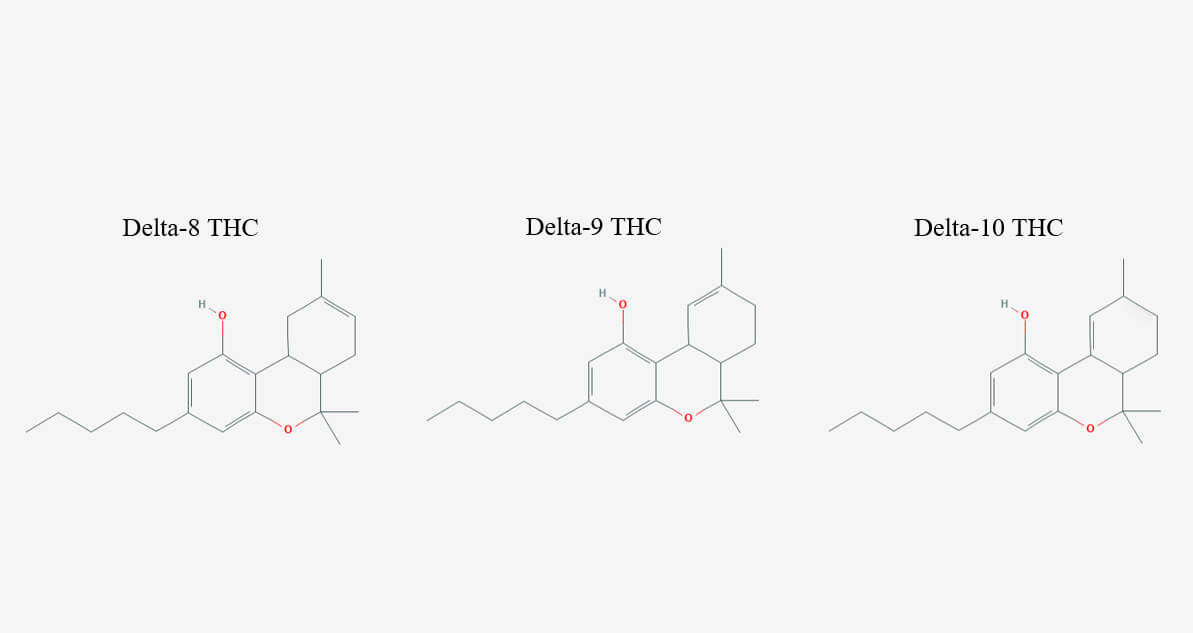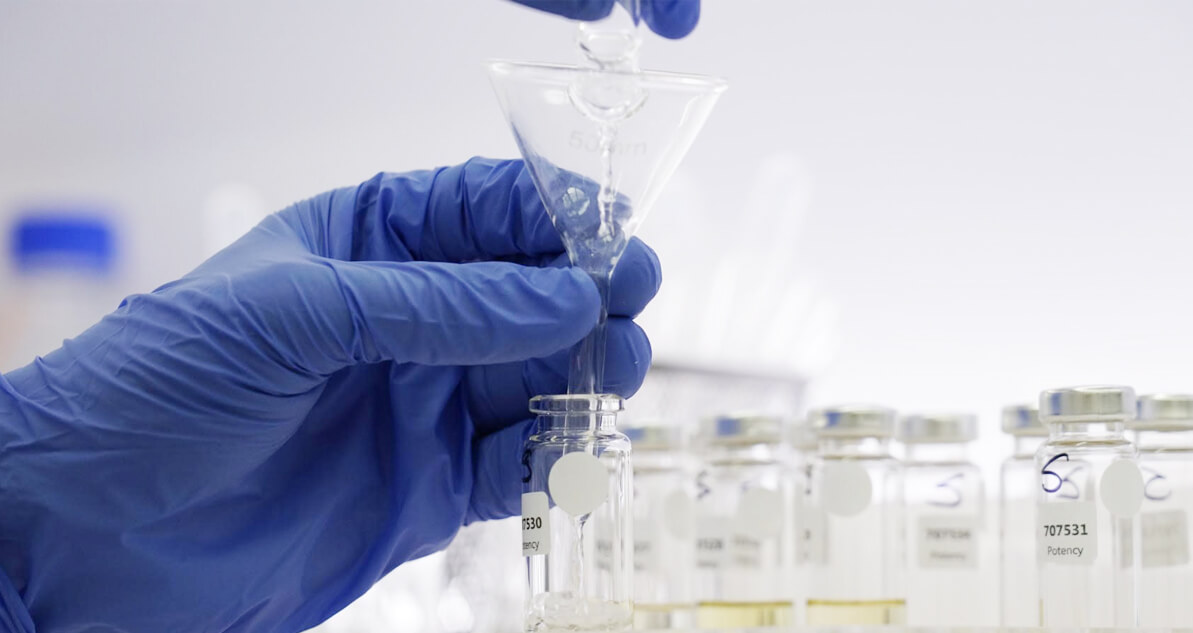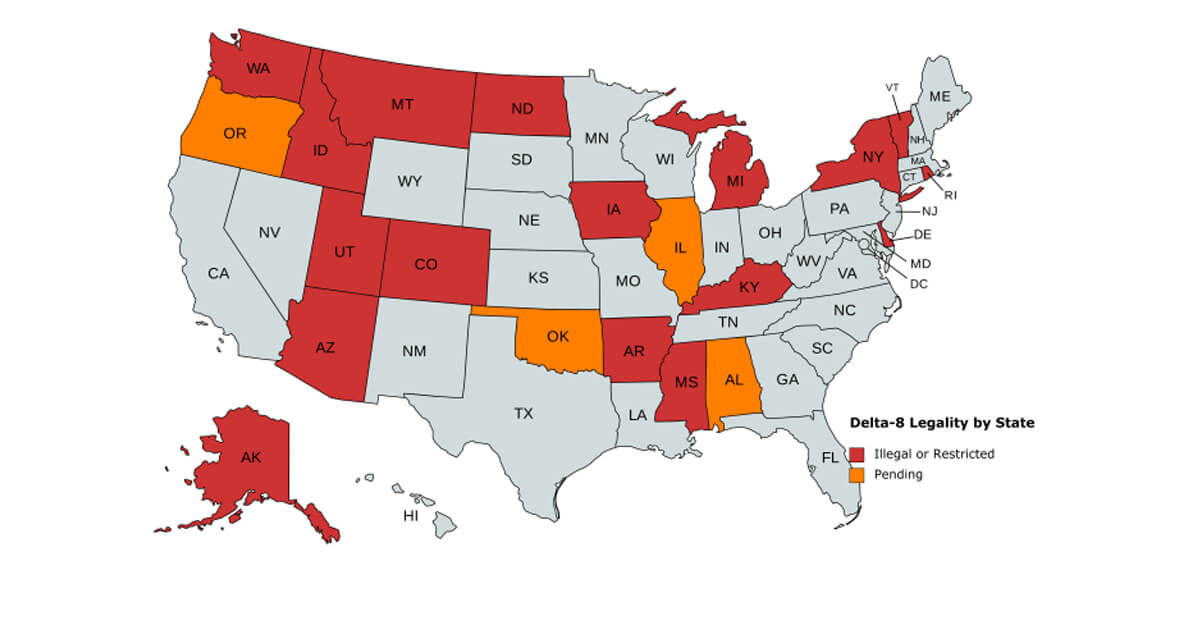This year, delta-10 THC, delta-9 THC and delta-8 THC (tetrahydrocannabinols) products have rapidly gained popularity within the cannabis community. This article aims to explain what they are, how they are produced, their effects, uses, legal status and current market.
Delta 10, Delta 9 and Delta 8 THC Isomers and How They Differ
THC is the main psychoactive compound in cannabis that produces the intoxicating or ‘high’ effect in human consumption. Most naturally occurring THC, found largely in cannabis plants, is delta-9 THC, delta-8 and delta-10 THC are its isomers.
In chemistry, isomers refer to molecules which are made up of the same number and types of atoms but have differing arrangements of atoms in space. Isomers generally have similar connectivity with one another and often diverge only in one or two bonds. For example, Delta-8, delta-9 and delta-10 THC are all made up of 21 carbon atoms, 30 hydrogen atoms, and 2 oxygen atoms (C21H30O2). Delta-8 THC and delta-10 THC are distinct from delta-9 THC only in the location of the double bond in the cyclohexene moiety. Delta-9 THC has a double bond on the 9th carbon chain while delta-8 and delta-10 have a double bond on the 8th and 10th carbon chain, respectively (see Fig. 1 below). Delta-8 and delta-10 THC can be naturally found in cannabis, but usually in small or trace amounts, with only delta-8 occurring occasionally in higher amounts.

The slight difference in chemical structure results in significant differences in the properties of the isomers and their effects on the human body. Delta-9 THC has a high affinity for CB1 (G-coupled) receptors of the endocannabinoid system, primarily located in the brain and central nervous system. The CB1 receptor is responsible for mediating most of the psychotropic effects of THC, and delta-9 is a strong agonist at the receptor. Because of the difference in the location of one of the double bonds, delta-8 has half the potency of THC and binds weakly to the CB1 receptors. The isomerization of delta-9 THC into delta-8 THC, that is, when the double bond changes position, is induced by heating and/or acids. This is because delta-8 is thermodynamically more stable than delta-9 THC, which means it has a longer shelf life and is more resistant to oxidation. When delta-9 THC is exposed to heat or stored for long periods of time, it can degrade into delta-8 THC. Delta-10 THC tends to have an even weaker affinity for binding to the CB1 receptors compared to delta-8 and delta-9, resulting in milder effects.
The History of Delta-10 and Delta-8 THC
Delta-8 THC was first partially synthesized at the University of Illinois by Roger Adams and his team in 1941. The following year, the same team studied its physiological and psychoactive effects after oral dosing in humans. Significant breakthroughs in delta-8 research took place in the mid-1960s: total syntheses were achieved in 1965, the chemical structure was characterized in 1966, and a stereospecific synthesis was achieved in 1967. Research into the effects of delta-8 THC in humans began in 1973, where one study compared the experiences of six participants who were given the same amounts either delta-8 or delta-9 by oral and intravenous administration. More recent studies have investigated the therapeutic potential of delta-8 THC, with a 1995 study, for example, finding that it was able to stop vomiting and nausea in children receiving chemotherapy treatment for cancer. Delta-8 THC was often referred to as delta-6 THC in early scientific literature, but this name is no longer conventional, and delta-8 is now commonly used. The history of delta-10 THC is much less clear, but it was first synthesized in the laboratory in the 1980s and a pigeon study of its psychoactive effects was performed in the same decade.
How Delta-10 and Delta-8 THC Are Produced?
As mentioned above, delta-8 THC is a natural component of cannabis and can be identified in the plant using advanced analysis like HPLC (high-performance liquid chromatography). It can be made in a laboratory in larger quantities and more economically, however, from CBD (cannabidiol). CBD, in turn, is usually derived from hemp, a variety of cannabis plant bred without psychoactive THC and used to manufacture fiber, biofuel, and bioplastics. Hemp flower is extracted for CBD isolate or pure CBD (over 98% in concentration), which goes through an extensive process to be transformed into a distillate. A solvent is added to the isolate to melt it down, and then an acid reagent is added to cause a chemical reaction. After the substance is neutralized with an alkaline material, washed, and distilled, the resulting final distillate ends up being 60% to 70% delta-8 and roughly 2% to 6% delta-9. Proper manufacturers would then run the distillate through extensive chromatography to remove the delta-9 or dilute it down, in order to be compliant with the U.S. Department of Agriculture rule on hemp (discussed below). The sample is extracted so that the lab can isolate delta-8, delta-9, pesticides, solvents, and other interferences.
Unlike delta-8, delta-10 THC appears in such small amounts that testing for it is challenging even with HPLC methods. Laboratories often mistake the isomer for CBC (cannabichromene) or CBL (cannabicyclol). Since extraction from natural varieties would require significant time and raw material, delta-10 THC is largely produced in a laboratory from delta-9 or hemp-derived CBD, similar to delta-8. When using crude CBD, carbon and vitamin C derivatives are used to induce the chemical reaction, while solvents and acids are used when using CBD isolate. When samples of delta-8 or delta-10 get tested, they get measured against known reference materials so the laboratory can record the percentage of delta-8 or delta-10 (or delta-9, for that matter) in the sample. The availability of reference materials and non-standardized methods can be a bottleneck for testing these isomers. Reference materials for delta-8 is more widely available now than it was five years ago, and so testing for delta-8 has become easier, but testing for delta-10 still presents a challenge for laboratories and the industry at large.

The Effects of Delta-10 and Delta-8 THC
The National Cancer Institute describes delta-8 THC as containing neuroprotective properties that can increase appetite and reduce nausea, anxiety and pain. It also produces psychotropic effects that, due to the chemical structure mentioned above, are less potent than those of delta-9 THC. Unlike CBD, however, delta-8 still induces the same intoxicating or euphoric sensation (‘high’) as delta-9, although consumers have reported a clearer mind and more relaxing effect. Similar to delta-9, vaping, smoking, or sublingual consumption of substances with delta-8 THC produces a more rapid effect (30 minutes or less), while the effects from oral consumption and ingestion take longer (up to 2 hours) but produce a heavier, more intense sensation. This is because pharmacologically, delta-8 THC edibles function in a similar way to their delta-9 counterpart, with both molecules converting into 11-hydroxy-THC in the liver. More research into the side effects of consuming delta-8 is required, but one can assume that the common effects of delta-9 THC such as dry mouth, red eyes, anxiety or paranoia, may occur, although potentially to a lesser extent. The current available evidence indicates that delta-8 THC has similar therapeutic effects to delta-9, with decreased potency.
Again, there is less scientific research available into the effects of delta-10 THC, although it is widely believed that its psychotropic potency is similarly less than delta-9. Delta-10 is reportedly almost double in psychotropic potency compared to delta-8, but it is typically half as concentrated in distillate form, resulting in comparable levels of intensity for the same amount or ‘serving’. Consumers have also reported a different euphoric effect compared to delta-8, promoting greater creativity, alertness, and energy rather than a relaxed or calm sensation. Similar to delta-8, the side effects of THC like paranoia and anxiety are likely reduced in delta-10, although more extensive study into the topic is needed.
Delta 10 vs Delta 8 THC Potential Therapeutic Uses
Since delta-10 THC is not as widely available and there is a lack of research into its therapeutic benefits, the following will focus on the uses of delta-8 THC based on current evidence:
Pain Relief
A 1977 preclinical study on rats reported that delta-8 THC provides pain relief, although tolerance to the substance developed rapidly. A more recent preclinical mouse study from 2018 indicated that delta-8 THC helped relieve pain and inflammation. While the study is specifically related to corneal injury of the eye, the result shows a link to the delta-8’s effect on the CB1 receptor and supports anecdotal report by delta-8 consumers that cite pain relief as their reason for using the product.
Appetite Stimulation
A 2004 mouse study concluded that small doses of delta-8 THC led to increased appetite, resulting in a 22% increase in food intake compared to control trials. The report mentions that this increase in food intake is significantly higher compared to delta-9 THC, which is a known appetite stimulant.
Anxiety
The U.S. National Center for Biotechnology Information identifies delta-8’s anxiety-reducing qualities as similar to delta-9.
Nausea Reduction
A 1995 study followed eight pediatric cancer patients for over two years and found that no vomiting occurred when patients ingested delta-8 THC before and for 24 hours after chemotherapy, with very few side effects.
Substance Abuse Therapy
A 2001 study into morphine withdrawal in mice concluded that delta-8 was able to reduce the severity of withdrawal symptoms, which highlights its potential as a therapeutic mechanism in cases of opioid substance abuse.
Are the Delta-10 and Delta-8 THC Legal?
In the past few years that delta-8 and delta-10 THC has risen in popularity and demand, there has been considerable ambiguity over the isomers’ legal status in the United States. In 2018, with the support of Senator Mitch McConnell, the U.S. Congress attached a provision called the Domestic Hemp Production Program to the Agriculture Improvement Act of 2018 (also known as the 2018 Farm Bill). In essence, the bill allows hemp to be legally grown and used for extractions all over the United States, along with the transfer of hemp-derived products across state lines. Hemp is defined as “the plant species Cannabis sativa L. and any part of that plant, including the seeds thereof and all derivatives, extracts, cannabinoids, isomers, acids, salts, and salts of isomers, whether growing or not, with a delta-9 tetrahydrocannabinol concentration of not more than 0.3 percent on a dry weight basis. … Delta-9 tetrahydrocannabinol, or THC, is the primary intoxicating component of cannabis.” Because these regulations only specify the rules for delta-9 THC, many are under the impression that the production of isomers, such as delta-8 and delta-10 THC, is allowed. Under this interpretation, delta-9 and delta-10 THC would be legal even in states where delta-9 THC is illegal, even though they produce similar effects.
Some experts, however, disagree with this interpretation. The first reason for this is the Drug Enforcement Administration (DEA)’s interim final rule addressing the implementation of the bill. The rule states that THC is illegal when synthetically produced from cannabis, and most commercially available delta-8 and delta-10 THC compounds may fall under this category if they are converted in a laboratory from isomerized CBD. In addition, the Federal Code for Treatment of Controlled Substance Analogues, or the Analogue Act, stipulates that any drug which is chemically closely related to a controlled substance in Schedule I, is also treated as Schedule I and therefore illegal.

Map of delta-8 THC legality by state as of June 2021 (Greenway)
It is also important to note that many states have deemed all THCs as Schedule I substances, which likely extends to any and all isomers. These states likely have chosen not to adopt the specific language of the 2018 Farm Bill in their state laws, and therefore do not have a hemp definition that exempts it from cannabis or marijuana. On the other hand, few state laws currently address delta-8 or delta-10 THC, with most state laws pertaining to cannabis or marijuana using language that only covers delta-9 THC. Nevertheless, delta-8 THC manufacturers and retailers have largely decided to sell and/or ship their products to states which have laws mirroring language of the 2018 Farm Bill. 16 states have implemented delta-8 bans, including Alaska, Arizona, Arkansas, Colorado, Delaware, Kentucky, Idaho, Iowa, Mississippi, Montana, New York, North Dakota, Rhode Island, Utah, Vermont, and Washington, with Alabama, Illinois, Michigan, Oklahoma, and Oregon, possibly joining them (see Fig. 3 above). Delta-10 THC, on the other hand, is somewhat undetected, with only Alabama, Colorado and New York starting to move against it, but it may not remain so for long.
On the federal level, some marijuana lawyers believe that the DEA’s rule should be struck down as invalid because the 2018 Farm Bill explicitly excludes “tetrahydrocannabinols in hemp” from the list of Schedule I substances. There is also no definition of ‘synthetic’ in the Controlled Substances Act. Much of the delta-8 and delta-10 THC on the market, for example, is converted in laboratories from CBD derived from hemp—this hemp is legally grown with less than 0.3% THC. Overall, delta-8 and delta-10 are not mentioned by name in the 2018 Farm Bill, the DEA’s final rule or the Controlled Substances Act. DEA’s rule also conflicts with the agency’s own, as well as the Department of Justice (DOJ)’s, previous interpretations of ‘synthetic’. A DEA agent has been on record defining ‘synthetic cannabinoids’ refers to “designer drugs” developed from non-organic sources. A similar definition is used in a document by the National Institute on Drug Abuse on the DOJ’s website, specifying ‘synthetic cannabinoids’ as “man-made” and sometimes “sprayed on dried, shredded plant material.” The document mentions synthetic substances like “Spice” or “K2”, which mimic the effects of cannabis but with greater potency.
A case addressing the DEA’s rule is currently moving through the U.S. Court of Appeals in the District of Columbia Circuit. The Hemp Industries Association (HIA) and RE Botanicals of Conway, South Carolina, sued the agency over the rule in September 2020. The lawsuit states that the rule ignored legal procedure and overstepped the DEA’s authority. If a court rules in favor of the HIA and RE Botanicals, there may be greater security for manufacturers dealing with delta-8 THC. The DEA’s rule is also open for review until October 2021, until which there is enough grey area around the legality of isomers. The low costs and resulting price of the hemp-derived isomers, discussed in the next section, has led marijuana farmers to push for increased restrictions to protect their own businesses.
Delta-10 and Delta-8 THC Vapes and Edibles Market
Delta-8 and delta-10 THC are generally sold as a vape product or an edible, although dabbing syringes and sprays are available, as well. They are being marketed to cannabis consumers as the lighter yet superior version of THC. The isomers are also taxed less heavily and hence priced lower than legalized cannabis. The different effects of the isomers mean they are meeting the needs for different consumers, delta-8 for consumers who want help with anxiety or sleep and delta-10 for those seeking energizing effects. Products that take advantage of both isomers exist, while some companies also add CBD to the mix. Overall, delta-8 is the more popular product, but there are so few suppliers for delta-10 that it is generally priced higher than delta-8. Due to their mild psychoactive effects, many consumers are consuming higher amounts—higher than they would CBD oil, for example. The trading volumes of delta-8 THC is a small proportion of the overall market for CBD products, but Hemp Benchmarks reported in January 2021 that it is the fastest-growing product in the hemp sector.
The current demand conditions and growth of the market present a positive trend for hemp farmers. Over the past three years, hemp has gone from extremely profitable to low-value due to the significant drop in the price of other hemp-derived products. Crude CBD oil, for example, has gone from more than $7,000 to $500 per kilogram. For many hemp farmers, their CBD biomass had become nearly worthless until the demand for isomers began to rise. The Hemp Benchmarks report suggests that processors might entertain the idea of synthesizing delta-8 THC from their surplus CBD and selling it for significantly higher prices in order to recoup their losses. Despite the higher costs and processing associated with isomers compared to crude CBD, the industry is increasing production in order to meet demands.
Conclusion
Scientific and technological advancements in the cannabis industry have resulted in new products and variations that address more specific medical and recreational needs. The delta-8 and delta-10 THC isomers could potentially deliver similar intoxicating effects as the more common delta-9 but with lower potency and lesser side effects. They are produced in the laboratory by inducing chemical reactions on hemp-derived CBD distillates. While more research is required, delta-8 THC shows promise in use for pain relief, appetite stimulation, nausea reduction, as well as therapy for anxiety and substance abuse disorders. The legality of delta-8 and delta-10 THC is in flux, with many states starting to ban the former. Nevertheless, the high demand for both isomers have created a lucrative market and new opportunities for hemp farmers, processors, and the cannabis industry at large.